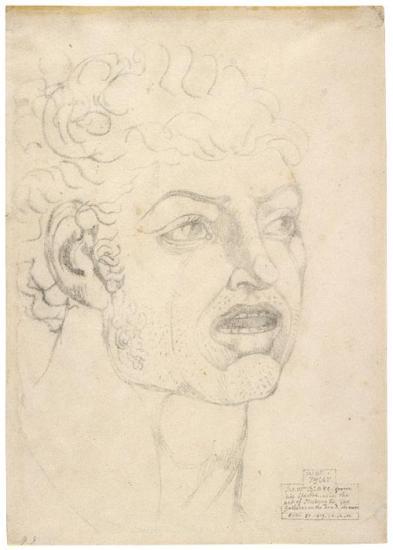
Wat Tyler
Inscribed (in the hand of John Varley) at lower right, Wat / Tyler / By Wm Blake from / his Spectre as in the act of Striking the Tax / Gatherer on the head. Drawn / Octr 30.1819 1h AM; numbered at lower left, 99.
Gift of Charles Ryskamp in memory of Michael S. Currier on the occasion of the 75th anniversary of the Morgan Library and the 50th anniversary of the Association of Fellows
Like Cowper, Blake was often considered mad because he spoke so naturally of the visions that he had experienced since childhood. Friends from later life described evenings during which they watched him drawing religious or historical figures whom he said were sitting before him. In 1819 he began to record these visions for John Varley (1778–1842). This is the last of a series of six documented during the month of October. Varley recorded the details on the drawings. The Morgan also owns a visionary head of Christ.
This sheet is Blake's portrait of the fourteenth-century rebel and leader of the revolt against the poll tax, Wat Tyler, who had been killed in 1381. Perhaps Blake felt a kinship based upon his own antimonarchical stance that had led to a trial for sedition in Felpham a few years earlier.
William Blake (1757–1827) occupies a unique place in the history of Western art. His creativity included both the visual and literary arts. In his lifetime he was best known as an engraver; now he is also recognized for his innovative poetry, printmaking, and painting. Blake's keen perception of the political and social climate found expression throughout his work. His strong sense of independence is evident in the complex mythology that he constructed in response to the age of revolution.
Blake was already recognized as an engraver at age twenty-five, when his first volume of poems appeared. At thirty-three, in The Marriage of Heaven and Hell, he audaciously claimed that his birth had marked the origin of a "new heaven" in which his own art would exemplify the creativity prefigured by Milton and Michelangelo. By that time, Blake, in one of his most productive periods, had already produced Songs of Innocence and was at work on a series of illuminated books. In 1818 he met John Linnell, a young painter and engraver, through whom a group of young artists became Blake's followers. Calling themselves the Ancients, they helped perpetuate Blake's influence for generations.
The Morgan's Blake collection—one of this country's most distinguished—began with purchases as early as 1899 by Pierpont Morgan. During the tenure of Charles Ryskamp, director from 1969 to 1986, major gifts almost doubled the size of its Blake holdings. In recent years Ryskamp's own gifts of engravings, letters, and related materials have significantly enriched its scholarly resources.
This online exhibition is presented in conjunction with the exhibition William Blake's World: "A New Heaven Is Begun" on view September 11, 2009, through January 3, 2010.
This exhibition is made possible through the generosity of Fay and Geoffrey Elliott.
